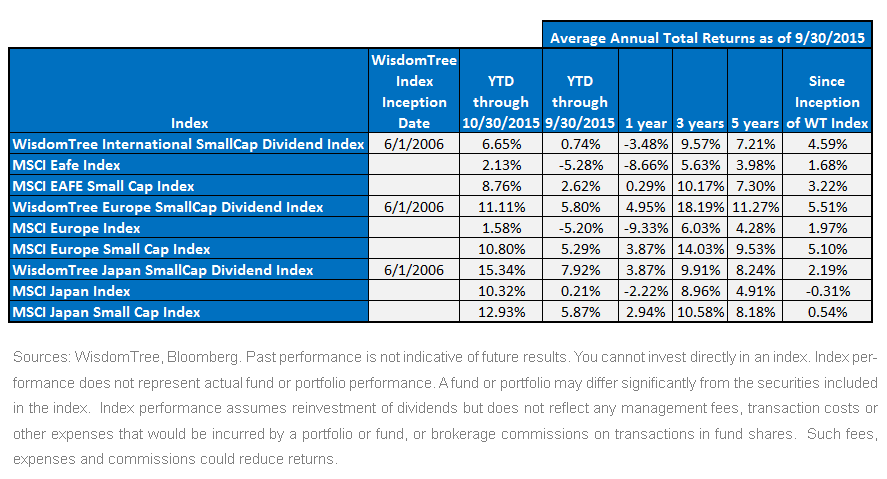The Smart Beta Rally That Many Investors Missed in 2015


 For definitions of indexes in the chart, visit our glossary.
What’s interesting is that the excess return produced by the small caps compared to their large-cap brethren is not just a 2015 phenomenon. Excess returns have held up over the last year, three years, five years and the better part of the last decade going back to the inception of the WisdomTree Indexes back in May of 2006.
When One Compares Returns across Asset Classes, Additional Light Bulbs Light Up
The double-digit gains European and Japanese small caps have generated thus far in 2015 have not only surpassed the broad European and Japanese benchmarks (MSCI Europe and MSCI Japan), they have outperformed the major asset classes investors typically tap to construct a globally diversified portfolio: large caps and small caps in the U.S.1; MSCI EAFE Index and MSCI Emerging Markets Index; REITs2, U.S. Treasuries, investment-grade and high-yield corporate bonds3; commodities4and gold5. Moreover, year-to-date in 2015, small caps measured by the WisdomTree Japan SmallCap Dividend Index and the WisdomTree Europe SmallCap Dividend Index outperformed each of the major indexes designed to measure how each smart beta factor is performing: MSCI Momentum, MSCI Quality, MSCI Value, MSCI Low Volatility or MSCI Size.
What accounts for the divergence in returns? Part of it can be explained by sector concentrations, country and currency exposure. Another reason: Small-cap stocks are less tied to the global economy and often more sensitive to inflections in local economies. This can be partly explained by the historic tendency of small-company stocks to outperform large caps. This is one of the reasons that back in 2006 WisdomTree became the first ETF manager to launch international small-cap ETFs. At that time, WisdomTree knew that international small caps not only added potential for higher returns compared to large caps but they could also provide diversification benefits to a globally diversified portfolio. Since its inception in 2006, for example, the WisdomTree Japan SmallCap Dividend Index had a correlation of .49 to the S&P 500. Adding components with lower correlations to one’s U.S. equity exposure has the potential to lower the overall volatility of a globally diversified portfolio.
Conclusion
Because most passive indexes and active international managers tend to concentrate primarily on large-cap stocks, international investors may miss the potential of small-cap companies unless they make a conscious effort to include them in their portfolios. We believe international small-cap exposure can help investors complete their international allocations. Returns this year in Europe, Japan and the developed world add additional real-time evidence to support our thesis.
Unless otherwise stated, data sources are Bloomberg and WisdomTree.
1S&P 500 and Russell 2000 Index.
2MSCI US REIT Gross Total Return and S&P Global ex-U.S. REIT USD Index.
3Barclays US Agg Corporate Yield-To-Worst and Barclays U.S. High Yield 2% Issr Cap Yield To Worst.
4Commodity Research Bureau BLS/US Spot all Commodities Index.
5Gold Spot Price Index.
For definitions of indexes in the chart, visit our glossary.
What’s interesting is that the excess return produced by the small caps compared to their large-cap brethren is not just a 2015 phenomenon. Excess returns have held up over the last year, three years, five years and the better part of the last decade going back to the inception of the WisdomTree Indexes back in May of 2006.
When One Compares Returns across Asset Classes, Additional Light Bulbs Light Up
The double-digit gains European and Japanese small caps have generated thus far in 2015 have not only surpassed the broad European and Japanese benchmarks (MSCI Europe and MSCI Japan), they have outperformed the major asset classes investors typically tap to construct a globally diversified portfolio: large caps and small caps in the U.S.1; MSCI EAFE Index and MSCI Emerging Markets Index; REITs2, U.S. Treasuries, investment-grade and high-yield corporate bonds3; commodities4and gold5. Moreover, year-to-date in 2015, small caps measured by the WisdomTree Japan SmallCap Dividend Index and the WisdomTree Europe SmallCap Dividend Index outperformed each of the major indexes designed to measure how each smart beta factor is performing: MSCI Momentum, MSCI Quality, MSCI Value, MSCI Low Volatility or MSCI Size.
What accounts for the divergence in returns? Part of it can be explained by sector concentrations, country and currency exposure. Another reason: Small-cap stocks are less tied to the global economy and often more sensitive to inflections in local economies. This can be partly explained by the historic tendency of small-company stocks to outperform large caps. This is one of the reasons that back in 2006 WisdomTree became the first ETF manager to launch international small-cap ETFs. At that time, WisdomTree knew that international small caps not only added potential for higher returns compared to large caps but they could also provide diversification benefits to a globally diversified portfolio. Since its inception in 2006, for example, the WisdomTree Japan SmallCap Dividend Index had a correlation of .49 to the S&P 500. Adding components with lower correlations to one’s U.S. equity exposure has the potential to lower the overall volatility of a globally diversified portfolio.
Conclusion
Because most passive indexes and active international managers tend to concentrate primarily on large-cap stocks, international investors may miss the potential of small-cap companies unless they make a conscious effort to include them in their portfolios. We believe international small-cap exposure can help investors complete their international allocations. Returns this year in Europe, Japan and the developed world add additional real-time evidence to support our thesis.
Unless otherwise stated, data sources are Bloomberg and WisdomTree.
1S&P 500 and Russell 2000 Index.
2MSCI US REIT Gross Total Return and S&P Global ex-U.S. REIT USD Index.
3Barclays US Agg Corporate Yield-To-Worst and Barclays U.S. High Yield 2% Issr Cap Yield To Worst.
4Commodity Research Bureau BLS/US Spot all Commodities Index.
5Gold Spot Price Index. Important Risks Related to this Article
Performance, especially for very short periods, should not be the sole factor in making your investment decision.
Foreign investing involves special risks, such as risk of loss from currency fluctuation or political or economic uncertainty.
Investments focusing on certain sectors and/or smaller companies increase their vulnerability to any single economic or regulatory development. Investments in commodities may be affected by overall market movements, changes in interest rates, and other factors, such as weather, disease, embargoes and international economic and political developments.
Diversification does not eliminate the risk of experiencing investment losses.


